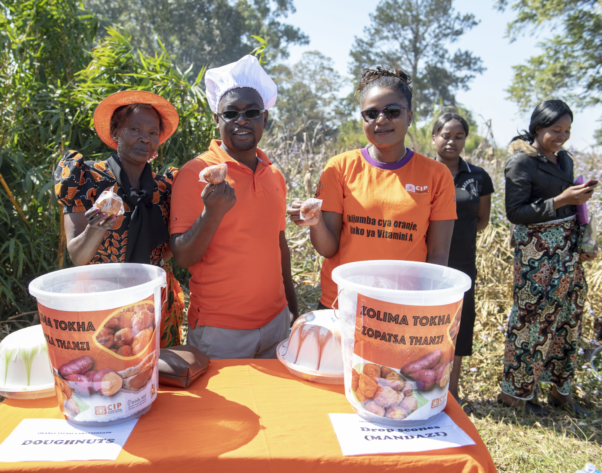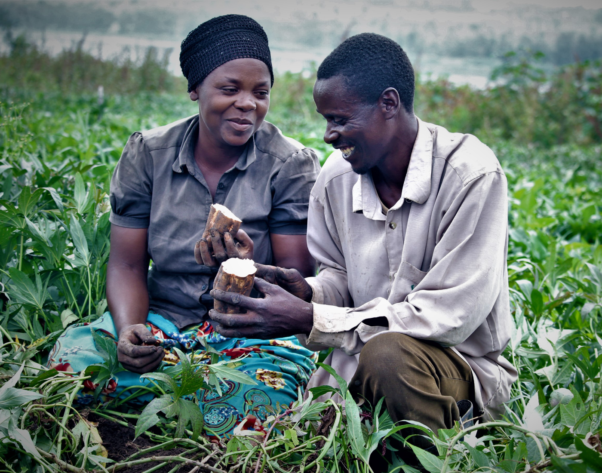
Plant breeder Dr. Jolien Swanckaert is part of a team committed to revolutionizing plant breeding and deliver new varieties of sweetpotatoes that grow well, taste good, deliver better nutrition, and meet the needs of farmers and consumers alike. Recently, she sat down with CIP communication specialist Vivian Atakos to share insights on how information is driving the development of new varieties.
Q: As a sweetpotato breeder how do you ensure that you have this variety that will be very attractive to the end users?
Swanckaert (JS): We work with a cross-functional team that provides input for trait prioritization, and these traits are captured in a product profile. The product profile focuses on replacing the market leading variety. Even the most preferred variety in the market at this point has its weaknesses, so we start by finding the good trait and then look for a replacement that is good as the current variety or even better.
Q: So as SweetGAINS (Sweetpotato Genetic Advances and Innovative Seed Systems) is a project that looks at both the breeding and the seed system what’s the value of you as a breeder working closely with the seed system actors as you develop new varieties?
JS: The seed system is often forgotten when developing new varieties. But we have seen the most liked variety in Uganda is a variety with strong vines and rapid multiplication. And varieties that suffer from disease, such as the sweetpotato virus disease they will need to be replaced much faster with clean material. It is important to include seed system actors and the discussion when formulating a product profile.
Q: How do we improve the access to markets through this project that you’re working on?
JS: Breeders need to breed for the current market, but they also have to recognize opportunities in developing markets. It’s takes about five to six years from the start of a new clone until we can get released varieties, so we have to predict the future. With Sweet Gains we generate new insights in the current market, so that new varieties that come out will be more effective. Currently we have so many new releases every few years, that people are a bit confused on the value of these new varieties. In Sweet Gains, the new standard is less is better. We want less varieties, but we want to be targeted and know that they will be adopted because they will meet end user needs.
The Abacus Bio study helps sweetpotato breeders create an index to put a monetary value on specific traits with the goal of helping to increase adoption of new varieties. (photo: Aime Ndaysiyenga/CIP)

Q: The CIP Uganda team recently conducted a study called Abacus Bio, can you tell us about and what you learned from it?
JS: Abacus Bio is a company that has supported us in a study on trait prioritization and the economic value of sweetpotato in Uganda. Abacus Bio surveyed a thousand people where the respondents were categorized into three groups each focusing on a different trait preference: productive output, plant robustness, and root quality. The ultimate goal of the study is to use economic values to create a common language and ranking of varieties to enable breeding programs to make decisions in a consistent way. So new varieties can be selected by specific actors in the seed system and enable the sellers to target varieties depending on the needs of the producers or the needs of the consumers. It will also the root producer to make an informed decision about the varieties they’re selecting.
Q: What are some lessons from the Abacus Bio Study that you feel will be valuable for other breeders working on other crops?
JS: The output of the study gave us a good insight into the current supply chain, so we now have a better understanding of what farmers want, what consumers want, and what processors want. We know that in the breeding program that these are the traits that we are working on, and when we develop a new variety, we will be able to put an economic value to that specific new variety. That means if we go to a seed multiplier and say well this is something new, it is better than what you have right now and you can sell it and you will earn, let’s say a hundred dollars more. Or if you go to a farmer and you say this will yield so much more your income will improve. Making that comparison is very important to see whether we are making progress or not. And as a breeder so you want to know your efforts are moving in the right direction. The index helps us know, if the market is still lacking something that say interests women, and the traits we need to target to develop a new variety to meet those needs.
The traits that men and women look for in sweetpotato varieties differ greatly. SweeGAINS implements a gender lens perspective to assure that preferences of both men and women are captured. (photo: CIP)

Q: Why is it important to get input from both men and women when developing new crop varieties?
JS: Men and women have different responsibilities, different priorities or needs and if you only target one group then you reduce your chances of success by half, because women are half of the population. If you don’t capture women’s needs you can cause harm, like having sweetpotatoes that are too heavy to harvest, which would make the women dependent on men. We also see that it’s women who will be in the kitchen peeling the sweetpotatoes and boiling them, so they put more emphasis on these quality attributes. Men mostly focus on the market or on the economic value, so having higher yields is more important for men.
Q: Given those risks what are some of the things that most people don’t consider when they’re developing crop varieties?
JS: We have released superior productive and more nutritious varieties but mostly focusing on the agronomy related characteristics and less on the end-user preference and that has resulted in slow adoption of improved varieties. In the sweetpotato supply chain we have different actors with different preferences. Factors attributed to socio-economics or gender are not captured right now. We need to define how can we address the users’ needs so that we can increase the adoption of the new varieties.
Q: Anything else you’d like to add to our discussion?
JS: Well, breeding is a complex world and we need the input from so many people around us to produce something that will be adopted. My message would be please let us know what’s going on and we will capture it. We only succeed if the variety gets to the table, right, if people are eating it and consuming it and we can make it better by including the perspective of so many people.
Visit us on SoundCloud to listen to the SweetGAINS podcast featuring Jolien Swanckaert and other scientists modernizing plant breeding.
This interview has been edited for length and clarity.
